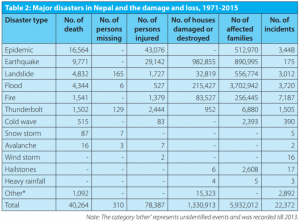Nepal, with its fragile geology and steep topography, is the 20th most disaster-prone country in the world (Dangal 2). With the additional impact of changing climate, this area, that highly prone to disasters, is greatly impacted. Because of climate change, one of the impacts has been an increase in monsoon variability. There has been an “increased frequency of extreme weather events such as landslides, floods and droughts resulting to the loss of human lives as well as social and economic costs” according to Nepal’s Nationally Determined Contribution(NDC) (Nationally Determined Contribution 1). These water-induced disasters, like stated by the NDC, have pose as great risks to multiple aspects of human security.
Monsoon variability has created risks that affect the economic growth, land, and livelihood. Even though water induced disasters are the most predicable events, “they are causing greater human suffering every year” (Dangal 1).

(This table from the Disaster Risk Reduction in Nepal: Achievements, Challenges and Ways Forward. Water related disaster like landslides, floods and heavy rainfall account for a large portion of the damages and losses.)
For agricultural communities, the instability makes farming even more challenging. The productivity of land is at risk with the heighten potential for crop failure. The economic livelihoods of the people who depend on agriculture will be impacted. This accounts for about 33.1% of Nepal’s GDP and is the main source of food, income and employment for 65.7% of the population as stated by the Ministry of Agricultural Development of Nepal (Karki 4). The majority of the population depends on agricultural in some way, so when thinking about who is at risk, ultimately everyone is impacted by the effects of monsoon variability. This climate change impact means that both people who supply food and demand food are impacted. The markets cannot be stable if the supply of food is volatile. Food is a mutually shared resource, and we are a part of the interconnected system. However, this being said some people and places experience more risk than others. For example, those who live in low lying regionals are at greater risk of experiencing flash floods than those who live in the mountains. Also, more vulnerable populations in society like Dhalits who come from a lower-class background may be more severely impacted. In the case of the Koshi Tappu wetland, poor farmers were not given the benefits of infrastructure from the dam, or the benefits of the resources. They are at greater risk than other members of the community.
In the 2011 Climate Change Policy, some changes to capabilities and resources are outlined. The policy that relates to water induced disasters include “formulating and implementing design standards for climate resilient construction of bridges, dams, river flood control and other infrastructure” (Ministry of Home Affairs 7). By focusing on improving our capabilities we can in turn improve the resources which are the assets we have such as bridges and dams. Another resource for climate adaptation and responding to risks is utilizing national and international financial resources. Making the Climate Change Fund, for example, more accessible for climate change-related programs would improve the ability to adapt and the resilience of communities (7). Other policy change that have been made are establishing species that can tolerate drought and flood conditions. This adaptation decreases the risk of crop failure. This approach to developing climate resilient infrastructure is also of importance in Nepal, so the Climate Change Policy has prohibited “development of human settlement in climate vulnerable areas” (9). In conclusion, though monsoon variability has cause an increase in risk there are climate change policies in place to adapt and mitigate disasters.

Photo: summer 2017 flood in Nepal
Works Cited
“Climate Change Policy, 2011.” PDF file, 17 Jan. 2011.
Dangal, Rameshwor. “Country Profile: Nepal.” Disaster Risk Management: Policies and Practices in Nepal, PDF ed.
Karki, Yogendra Kumar. “Nepal Porfolio Performance Review.” PDF file, 11 Sept. 2015.
Ministry of Home Affairs. “Disaster Risk Reduction in Nepal: Achievements, Challenges and Ways Forward.” PDF file, Nov. 2016.
Ministry of Population and Environment. “Nationally Determined Contribution.” PDF file, Oct. 2016.
